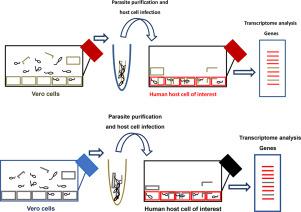当前位置:
X-MOL 学术
›
J. Proteomics
›
论文详情
Our official English website, www.x-mol.net, welcomes your
feedback! (Note: you will need to create a separate account there.)
Host-pathogen transcriptomics: Trypanosoma cruzi as a model for studying RNA contamination.
Journal of Proteomics ( IF 2.8 ) Pub Date : 2020-05-15 , DOI: 10.1016/j.jprot.2020.103804 María Gabriela Libisch 1 , Natalia Rego 2 , Florencia Díaz-Viraqué 1 , Carlos Robello 3
Journal of Proteomics ( IF 2.8 ) Pub Date : 2020-05-15 , DOI: 10.1016/j.jprot.2020.103804 María Gabriela Libisch 1 , Natalia Rego 2 , Florencia Díaz-Viraqué 1 , Carlos Robello 3
Affiliation

|
Cellular infection assays constitute essential tools to understand host-pathogen interactions, particularly for intracellular microorganisms that are produced in cell lines are needed to propagate the microorganism. In this work, we demonstrate that RNA derived from Vero cells is an important contaminant to consider in order to avoid false positive results in transcriptomic experiments. We study the cross-contamination on a Trypanosoma cruzi cell infection model, the etiological agent of Chagas disease. We implemented the most frequently used trypanosome-purification protocols and, for all of them, we detected RNAs derived from Vero cells in trypomastigote extracts. For some of the protocols we also detected Vero RNAs in infected human cells. We also found this type of contamination in microarray experiments of human samples infected with T. cruzi. Concerning Illumina RNA-Seq data, we found that the contamination with Vero cells is probably introducing spurious results. Finally, we recommend a protocol to purify trypomastigotes, which showed a high percentage of trypomastigote recovery and the absence of Vero contamination in infected human samples. Avoiding this type of contamination should be an important factor to consider during experimental design, in order to minimize false positive results in transcriptomic studies as well as RNA contamination in vaccine production. Kewwords: Trypanosoma cruzi; Transcriptomics; Vero cells derived trypomastigotes; RNA contamination; Host-Pathogen interaction. SIGNIFICANCE: Transcriptomic studies are widely used to understand host-pathogen interactions. When the pathogen is an intracellular microorganism, an additional mammalian cell system can be needed to propagate it. In this work we demonstrate that pathogens purified from infected monolayers can carry RNAs from these mammalian cells, and that this ambient RNA contamination is probably producing false positive results in subsequent transcriptomic studies performed with qRT-PCR, microarrays or Next Generation Sequencing.
中文翻译:

宿主-病原体转录组学:克氏锥虫作为研究 RNA 污染的模型。
细胞感染测定是了解宿主-病原体相互作用的重要工具,特别是对于在细胞系中产生的细胞内微生物,需要繁殖微生物。在这项工作中,我们证明了源自 Vero 细胞的 RNA 是一种需要考虑的重要污染物,以避免在转录组学实验中出现假阳性结果。我们研究了克氏锥虫细胞感染模型的交叉污染,该模型是恰加斯病的病原体。我们实施了最常用的锥虫纯化方案,并且对于所有这些方案,我们在锥鞭毛体提取物中检测到源自 Vero 细胞的 RNA。对于某些方案,我们还在受感染的人类细胞中检测到了 Vero RNA。我们还在感染 T. cruzi 的人类样本的微阵列实验中发现了这种类型的污染。关于 Illumina RNA-Seq 数据,我们发现 Vero 细胞的污染可能会引入虚假结果。最后,我们推荐了一种纯化 trypomastigotes 的协议,该协议显示 trypomastigote 回收率很高,并且受感染的人类样本中没有 Vero 污染。避免这种类型的污染应该是实验设计过程中要考虑的一个重要因素,以尽量减少转录组学研究中的假阳性结果以及疫苗生产中的 RNA 污染。关键词:克氏锥虫;转录组学;Vero 细胞衍生的锥体鞭毛体;RNA污染;宿主-病原体相互作用。意义:转录组学研究被广泛用于了解宿主-病原体相互作用。当病原体是细胞内微生物时,可能需要一个额外的哺乳动物细胞系统来繁殖它。在这项工作中,我们证明从受感染的单层细胞中纯化的病原体可以携带来自这些哺乳动物细胞的 RNA,并且这种环境 RNA 污染可能会在随后使用 qRT-PCR、微阵列或下一代测序进行的转录组学研究中产生假阳性结果。
更新日期:2020-05-15
中文翻译:

宿主-病原体转录组学:克氏锥虫作为研究 RNA 污染的模型。
细胞感染测定是了解宿主-病原体相互作用的重要工具,特别是对于在细胞系中产生的细胞内微生物,需要繁殖微生物。在这项工作中,我们证明了源自 Vero 细胞的 RNA 是一种需要考虑的重要污染物,以避免在转录组学实验中出现假阳性结果。我们研究了克氏锥虫细胞感染模型的交叉污染,该模型是恰加斯病的病原体。我们实施了最常用的锥虫纯化方案,并且对于所有这些方案,我们在锥鞭毛体提取物中检测到源自 Vero 细胞的 RNA。对于某些方案,我们还在受感染的人类细胞中检测到了 Vero RNA。我们还在感染 T. cruzi 的人类样本的微阵列实验中发现了这种类型的污染。关于 Illumina RNA-Seq 数据,我们发现 Vero 细胞的污染可能会引入虚假结果。最后,我们推荐了一种纯化 trypomastigotes 的协议,该协议显示 trypomastigote 回收率很高,并且受感染的人类样本中没有 Vero 污染。避免这种类型的污染应该是实验设计过程中要考虑的一个重要因素,以尽量减少转录组学研究中的假阳性结果以及疫苗生产中的 RNA 污染。关键词:克氏锥虫;转录组学;Vero 细胞衍生的锥体鞭毛体;RNA污染;宿主-病原体相互作用。意义:转录组学研究被广泛用于了解宿主-病原体相互作用。当病原体是细胞内微生物时,可能需要一个额外的哺乳动物细胞系统来繁殖它。在这项工作中,我们证明从受感染的单层细胞中纯化的病原体可以携带来自这些哺乳动物细胞的 RNA,并且这种环境 RNA 污染可能会在随后使用 qRT-PCR、微阵列或下一代测序进行的转录组学研究中产生假阳性结果。











































 京公网安备 11010802027423号
京公网安备 11010802027423号